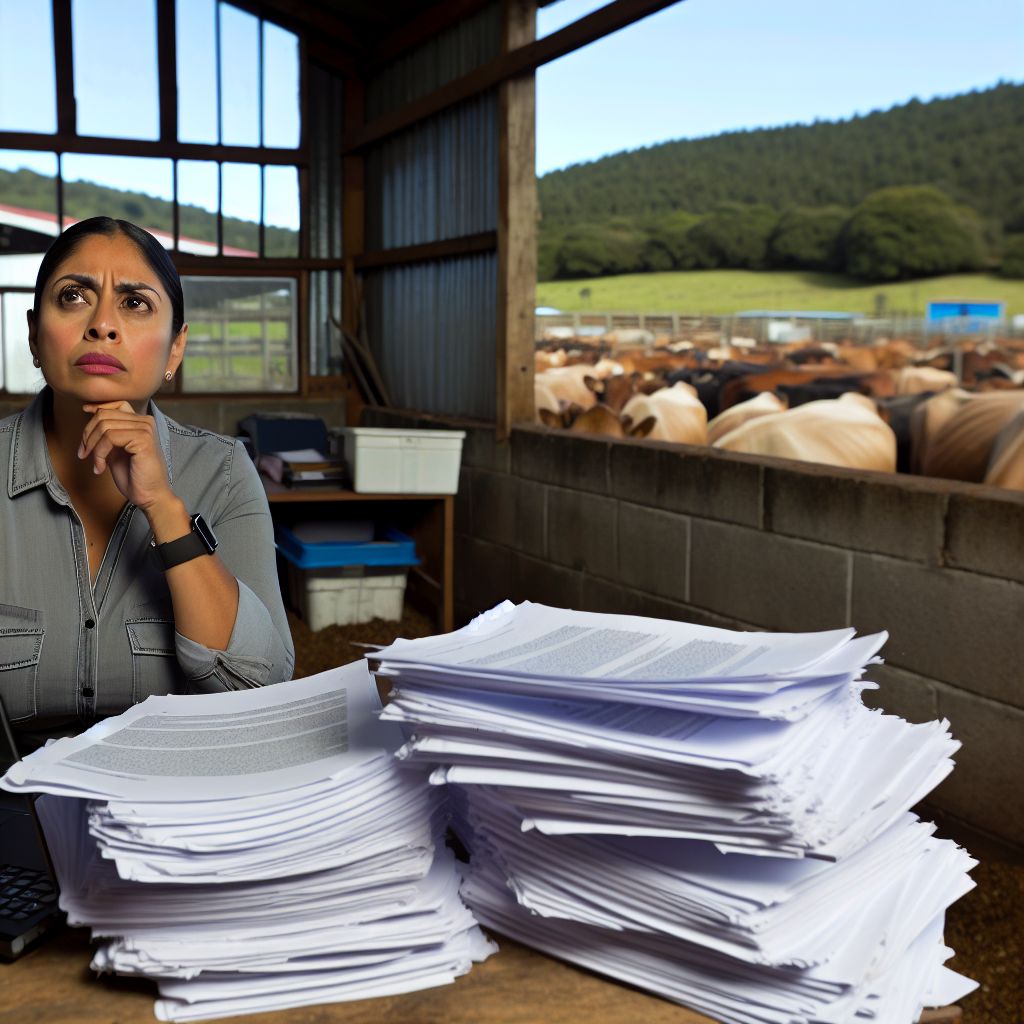Overview of Animal Welfare Legislation
Key Definitions and Principles
Animal welfare legislation aims to protect animals in agricultural operations.
It defines the rights of animals and sets standards for their care.
Principles of animal welfare focus on the physical and mental well-being of animals.
These principles emphasize the importance of humane treatment.
Key terms include “animal husbandry,” “welfare standards,” and “animal rights.”
Animal husbandry practices guide how farmers manage their livestock.
Welfare standards establish minimum conditions for animals.
Animal rights refer to the belief that animals deserve certain moral and legal protections.
Legislation Variations Across Regions
Countries have different laws regarding animal welfare.
For instance, the European Union has strict regulations to ensure animal well-being.
In contrast, some countries may lack adequate animal protection laws.
Moreover, each state may have its own set of regulations in the U.S.
Farmers must stay informed about local laws and requirements.
Compliance is crucial to avoid penalties and improve animal care.
Furthermore, understanding regional differences helps agricultural operations thrive.
Transform Your Agribusiness
Unlock your farm's potential with expert advice tailored to your needs. Get actionable steps that drive real results.
Get StartedImpact on Agricultural Practices
Animal welfare legislation influences farming practices significantly.
Farmers must implement humane practices to meet legal requirements.
This may include providing adequate space and proper food for animals.
Additionally, monitoring animal health becomes a priority.
Investment in training for farm workers is essential for compliance.
Moreover, consumers increasingly prefer products from humane operations.
As a result, farms may see financial benefits from adhering to welfare standards.
Challenges in Compliance
Adhering to animal welfare laws presents challenges for farmers.
Understanding complex regulations can be overwhelming.
Moreover, smaller farms may struggle to implement costly changes.
Access to resources and information is vital for compliance.
Collaboration with agricultural organizations can provide support.
Furthermore, farmers should engage in ongoing education regarding legal updates.
Finally, addressing these challenges is key to sustainable farming practices.
Historical Context: Evolution of Animal Welfare Laws in Agriculture
The Early Years of Animal Welfare Legislation
Animal welfare laws have a long and complex history.
In the early 19th century, societal attitudes toward animals began to shift.
This change prompted the formation of various animal protection organizations.
One notable example was the RSPCA, established in 1824 in the UK.
This organization aimed to prevent cruelty towards domestic animals.
Progress Through the 20th Century
The 20th century saw significant advancements in animal welfare legislation.
Countries began to implement laws that regulated animal treatment in agriculture.
The Humane Slaughter Act of 1958 in the U.S. marked a pivotal moment.
This act mandated humane handling and slaughter of livestock.
Such regulations highlighted the need for humane treatment in food production.
Showcase Your Farming Business
Publish your professional farming services profile on our blog for a one-time fee of $200 and reach a dedicated audience of farmers and agribusiness owners.
Publish Your ProfileRecent Developments and Trends
In the last few decades, awareness of animal welfare has increased dramatically.
Legislators have introduced various measures to strengthen animal protection laws.
For instance, the animal rights movement has gained prominent support.
As a result, many states in the U.S. have enacted stricter laws.
International Standards and Agreements
Globally, animal welfare standards have been established through treaties.
The World Organisation for Animal Health (OIE) plays an essential role.
It has developed animal welfare guidelines that many countries adopt.
These international standards aim to harmonize animal welfare practices worldwide.
Challenges and Future Directions
Despite progress, significant challenges remain in enforcing animal welfare laws.
Many agricultural operations struggle to comply with these regulations.
Additionally, there is ongoing debate about the effectiveness of current laws.
Future efforts should focus on improving compliance and enforcement.
Innovative solutions and community involvement can drive meaningful change.
Current Animal Welfare Regulations: A Breakdown by Region or Country
North America
In the United States, animal welfare regulations vary by state.
For example, California has strict standards for farm animal confinement.
Similarly, Florida enforces laws to prevent cruelty to animals.
Canada also has national guidelines that protect farm animals.
Moreover, provincial regulations outline specific welfare standards.
Europe
The European Union has comprehensive animal welfare laws.
EU regulations cover the treatment of animals across member states.
For instance, the Welfare of Animals at the Time of Killing Directive mandates humane slaughter methods.
Furthermore, the EU promotes higher welfare standards for livestock farming.
Countries like Switzerland have even more stringent regulations in place.
Asia
In Asia, animal welfare regulations differ significantly between countries.
Japan has enacted laws focusing on the humane treatment of pets and livestock.
However, countries like China are still developing their animal welfare frameworks.
India’s Prevention of Cruelty to Animals Act reflects growing awareness of animal rights.
Countries are gradually introducing more robust legislation in response to global trends.
Australia and New Zealand
Australia maintains a national framework for animal welfare legislation.
These laws apply to both agricultural operations and companion animals.
Similarly, New Zealand’s Animal Welfare Act emphasizes animal well-being.
Both countries have organizations working to promote higher standards.
This helps ensure that humane practices are followed in agriculture.
Africa and South America
In Africa, animal welfare regulations often face enforcement challenges.
However, some countries have introduced legislation to protect animals.
Meanwhile, South America’s approach to animal welfare varies widely.
Brazil, for instance, has made strides in developing animal protection laws.
Nonetheless, enforcement and compliance remain ongoing issues.
Global Trends and Future Directions
Animal welfare legislation continues to evolve worldwide.
There is a growing trend towards stricter regulations and enforcement.
Showcase Your Farming Business
Publish your professional farming services profile on our blog for a one-time fee of $200 and reach a dedicated audience of farmers and agribusiness owners.
Publish Your ProfileIn addition, consumers increasingly demand humane treatment of animals.
Consequently, many organizations advocate for enhanced welfare standards.
Ultimately, these forces shape the future of agricultural operations globally.
Find Out More: Essential Trade Agreements Every Farmer Should Be Aware Of
Impact of Animal Welfare Legislation on Agricultural Practices
Overview of Animal Welfare Legislation
Animal welfare legislation aims to protect the well-being of farm animals.
This legislation covers various aspects of animal care and handling.
Governments promote humane practices through these laws.
Additionally, public opinion influences the development of such regulations.
Changes in Farming Operations
Farmers must adapt their operations to comply with new regulations.
For instance, housing requirements for livestock have become stricter.
This often requires significant investments in infrastructure.
Moreover, practices such as tail docking and dehorning face increased scrutiny.
Financial Implications
Implementing animal welfare measures can be financially burdensome for farmers.
Initial costs for upgrading facilities can deter some operators.
However, improved practices can lead to better market prices.
Consequently, many farmers view these changes as long-term investments.
Consumer Influence
Consumer demand for ethically sourced products is rising.
This trend drives many businesses to adopt higher welfare standards.
Consumers often seek transparency regarding animal treatment.
Therefore, producers must provide evidence of compliance with welfare standards.
Benefits of Compliance
Complying with animal welfare legislation offers several advantages.
First, it enhances the reputation of agricultural products.
Second, it can reduce the risk of legal fines and penalties.
Third, improved welfare often correlates with better animal health.
This can lead to increased productivity and profitability over time.
Uncover the Details: Navigating Government Incentives for Farm Renewable Projects
Compliance Strategies for Farmers
Understanding Animal Welfare Legislation
Animal welfare legislation varies by region and country.
Farmers must be aware of local laws to remain compliant.
These laws often focus on the humane treatment of farm animals.
Knowledge of these regulations helps farmers avoid penalties.
Assessing Current Practices
Farmers should evaluate their current animal care practices.
Identify areas that may fall short of legal standards.
Performing regular audits can uncover potential compliance issues.
Making necessary adjustments promotes both welfare and compliance.
Implementing Best Welfare Practices
Using best practices can lead to higher welfare standards.
Ensure that animals have adequate space and shelter.
Provide proper nutrition and veterinary care as needed.
Farmers should also offer social interaction among animals.
Transparency in practices enhances overall public trust.
Training and Education
Continuous education is essential for all farm staff.
Showcase Your Farming Business
Publish your professional farming services profile on our blog for a one-time fee of $200 and reach a dedicated audience of farmers and agribusiness owners.
Publish Your ProfileTraining programs should cover welfare regulations and practices.
Workers must understand the importance of humane treatment.
Fostering a culture of welfare can improve compliance.
Documenting Compliance Efforts
Maintaining clear records aids in compliance verification.
Document animal care practices, training sessions, and health checks.
This information can serve as evidence during inspections.
Being organized can streamline interactions with regulatory bodies.
Engaging with Regulatory Bodies
Farmers should actively engage with local regulatory authorities.
Building relationships can help clarify regulations and expectations.
Participating in workshops or meetings provides valuable insights.
Staying informed about changes in laws is crucial.
Utilizing Technology for Compliance
Adopting technology can assist in monitoring and compliance.
Software solutions can track animal health and welfare metrics.
Farmers can also use apps to document care practices effectively.
Investing in technology offers long-term benefits for compliance.
Explore Further: Top Strategies for Farmers to Obtain Research and Development Funding

Animal Welfare Certification Programs: Benefits and Challenges
Importance of Certification in Agriculture
Animal welfare certification programs play a critical role in agricultural operations.
These programs establish standards for humane treatment of animals.
Consequently, they promote responsible farming practices.
Moreover, certification helps improve consumer trust in agricultural products.
Benefits of Animal Welfare Certification Programs
First, certification can enhance market access for farmers.
Many consumers prefer products from certified sources.
This preference can lead to higher sales and prices.
Second, certification may provide farmers with a competitive advantage.
Being certified can differentiate products in the marketplace.
Additionally, certified farms often experience reduced regulatory risks.
With proper certification, farms can avoid penalties and fines.
Challenges of Implementing Certification
Despite the benefits, implementing these programs can be challenging.
Many farmers face high costs associated with the certification process.
In addition, meeting the rigorous standards can require significant investments.
Moreover, the certification process can be complex and time-consuming.
Farmers often need to navigate various rules and documentation requirements.
Case Studies of Successful Certification
Several farms have successfully implemented certification programs.
The Green Pastures Dairy Farm achieved certification after rigorous training.
As a result, they experienced a 30% increase in sales.
Another example is Sunny Fields Poultry Farm.
They improved animal handling practices and met certification standards.
This change led to increased consumer loyalty and sales growth.
Future of Animal Welfare Certification Programs
The future of animal welfare certification looks promising.
Increased consumer awareness drives demand for certified products.
Showcase Your Farming Business
Publish your professional farming services profile on our blog for a one-time fee of $200 and reach a dedicated audience of farmers and agribusiness owners.
Publish Your ProfileFurthermore, technological advancements offer new tools for monitoring animal welfare.
As a result, more farms are expected to pursue certification.
Ultimately, these programs will likely evolve to meet changing consumer expectations.
You Might Also Like: Types Of Conservation Programs Available To Farmers
Case Studies: Successful Implementation of Animal Welfare Practices
Family Farms Leading the Way
Johnson Family Farms showcases a commitment to animal welfare.
They implement low-stress handling techniques for livestock.
This approach reduces anxiety and promotes better animal health.
Moreover, their dedication boosts productivity and profits.
Corporate Responsibility in Food Production
Green Valley Foods set new standards in humane practices.
The company revamped its supply chain for better animal care.
They partnered with local farms to ensure compliance.
As a result, consumer trust significantly increased.
Innovative Technologies in Animal Care
AgriTech Solutions developed monitoring systems for livestock.
These systems track animal health and welfare in real-time.
Handheld devices allow immediate response to potential issues.
Consequently, this technology enhances overall herd management.
Community Engagement for Better Understanding
Farmers United organized outreach programs for local communities.
These programs educate the public on animal welfare practices.
Through workshops and tours, they raise awareness effectively.
This transparency strengthens community relationships and support.
Best Practices for Continuous Improvement
Regular training sessions ensure employees stay informed.
Monitoring animal behavior helps identify areas for improvement.
Additionally, feedback from veterinarians supports best practices.
Ultimately, these efforts foster a culture of excellence.
Future Trends in Animal Welfare Legislation
Increased Regulatory Focus
Animal welfare legislation will see intensified scrutiny in the coming years.
Lawmakers are increasingly aware of public sentiment regarding animal rights.
For instance, state-level regulations are already tightening standards for livestock treatment.
Moreover, consumer demand is pushing for greater transparency in production practices.
As a result, agricultural operations must adapt quickly and effectively.
Advancements in Technology
Technology will play a crucial role in shaping future legislation.
Innovative monitoring systems will ensure compliance with animal welfare standards.
Technologies like AI and IoT can help farmers track animal health in real-time.
Consequently, these advancements may lead to more humane treatment practices.
Additionally, data analytics can provide insights into improving animal husbandry.
Global Harmonization of Standards
Countries are beginning to align their animal welfare laws more closely.
International trade agreements may incorporate animal welfare standards.
This movement towards harmonization will impact agricultural producers worldwide.
It will require compliance with increasingly standardized regulations.
Furthermore, this trend reflects a growing global consciousness about animal rights.
Public Engagement and Accountability
Public engagement will become a driving force in legislative changes.
Showcase Your Farming Business
Publish your professional farming services profile on our blog for a one-time fee of $200 and reach a dedicated audience of farmers and agribusiness owners.
Publish Your ProfileNon-governmental organizations are vital in raising awareness about animal welfare issues.
As a result, consumers are more likely to support brands that prioritize ethical practices.
This shift creates accountability for agricultural producers.
Ultimately, businesses must be proactive in communicating their welfare efforts.
Additional Resources
Agricultural Producer Subsidies: Navigating Challenges and Policy …
Laws & Policies: Marine Mammal Protection Act | NOAA Fisheries




